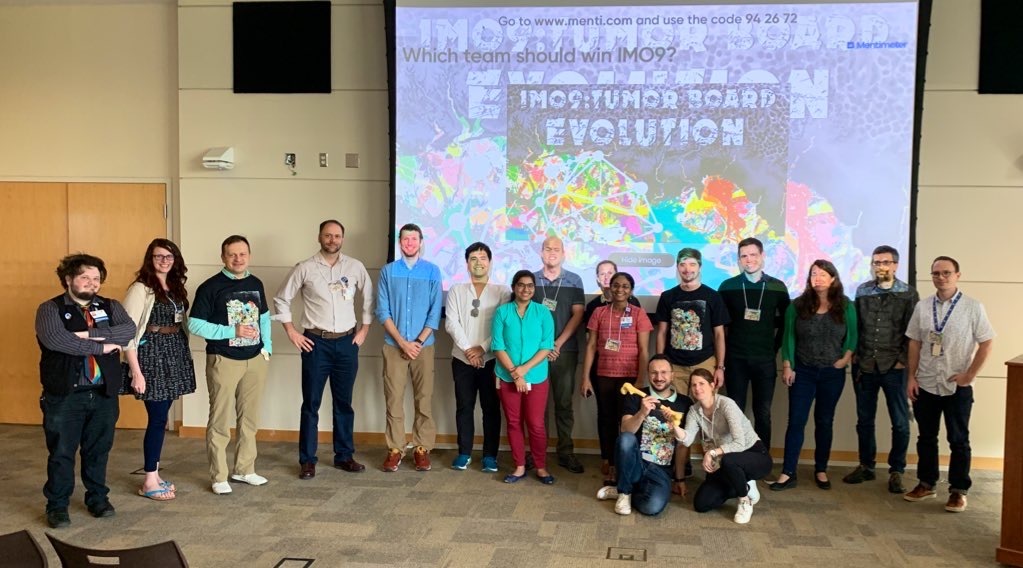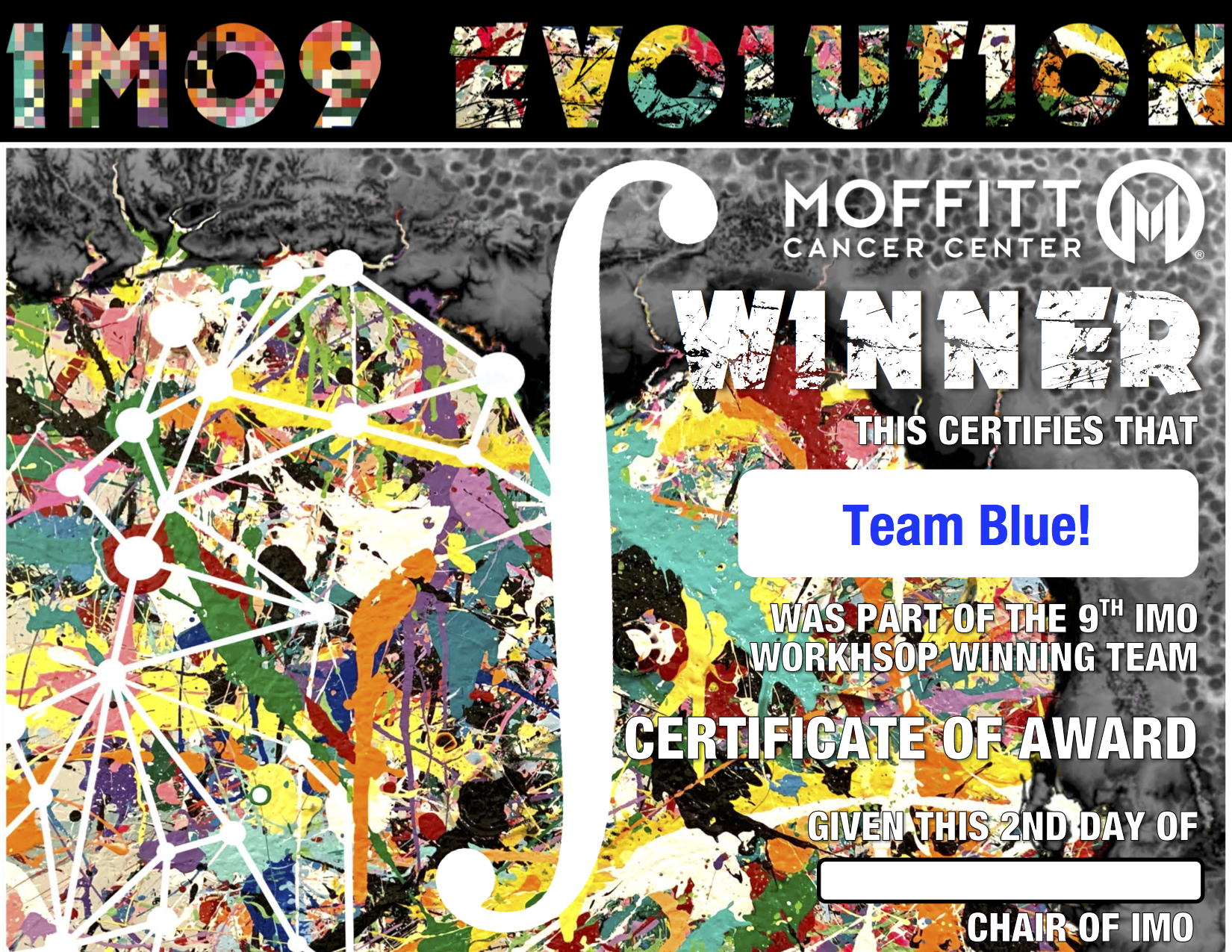IMO 9: Tumor Board Evolution

Tumor Board Evolution
Moffitt Cancer Center under the auspices of the Center for Evolutionary Therapy has recently established the worlds 1st Evolutionary Tumor Board (ETB). Chaired by Drs. Christine Chung and Damon Reed, the board consists of clinical physicians, evolutionary biologists, and mathematicians. The ETB provides guidance on optimal evolution based treatment strategies for individual patients and for the design of clinical trials. Equally important, the ETB itself is being treated as a formal clinical trial. Patients that go through the ETB are registered, followed, and mathematically modeled. The ETB rigorously formulates and investigates underlying hypotheses for treatment failure and success. Mathematical models are being used to predict potential disease trajectories and treatment responses. Patient data and treatment efficacy will be matched to model predictions, and models will be updated accordingly, to deliver more accurate predictions over the course of treatment.
A major open question is how to effectively and efficiently integrate individual patient data, covering diverse scales and sources, to facilitate treatment decisions in a real time patient specific manner. Therefore the ambitious focus of this year's workshop is to try, in under week, to come up with novel methods to deliver treatment decision plans for individual patients across a number of cancers.
Presenting the Research Question
Team Blue
Here Daniel Glazar from the @EnderlingLab #TeamBlue defines their question #moffittIMO pic.twitter.com/3bOWMJmDFi
— Sandy Anderson (@ara_anderson) November 4, 2019
Team Gold
Next @EinsteinCross from #TeamGold presets their question #moffittIMO pic.twitter.com/cRCqBYsmdt
— Sandy Anderson (@ara_anderson) November 4, 2019
Team Red
Next it’s @luddyka presenting #T4Red’s question #moffittIMO pic.twitter.com/7XOHt2KhSN
— Sandy Anderson (@ara_anderson) November 4, 2019
Team Green
Next oncologist Damon Reed from #TeamGreen presents their question #moffittIMO pic.twitter.com/LOVrbWYi9x
— Sandy Anderson (@ara_anderson) November 4, 2019
Team Orange
Last but not least is a double act for #TeamOrange with oncologist Dawn Lemanne & @dbasanta lab member @annakmil presenting their question #moffittIMO pic.twitter.com/rgEC7zDasd
— Sandy Anderson (@ara_anderson) November 4, 2019
And the winner is...
Winning team: specific aims
"Fatal attraction: Using cancer traps against glioblastoma"
Click to download a pdf of the winning team's specific aims.
Recurrent glioblastoma (GBM) patients face a dismal prognosis with median overall survival rates of less than one year. Patients accrued to a recent Phase 1/2 clinical trial (MCC 17978) of combining hypofractionated stereotactic radiation (HFSR; 6 Gy x 5 fractions) with bevacizumab (Avastin) and pembrolizumab (anti PD-L1) had promising responses – yet median time to progression remains less than 7 months. There is a critical unmet clinical need to improve response rates and overall outcome for GBM. While HFSR is very efficient in eradicating cancer cells, radiation of the whole brain is too toxic for the patient. The highly diffusive nature of GBM leaves a large population of cancer cells outside the radiation target volume necessitating the additional therapies. The current protocol of continuous maximum tolerable dose bevacizumab and pembrolizumab (B/P) is applied without consideration of evolutionary dynamics, and every patient inevitably develops resistance. We hypothesize that improving GBM outcomes requires two novel approaches: (1) to increase the number of post-surgery residual cancer cells exposed to curative radiation using an ecological trap, and (2) to deploy novel B/P protocols that harness evolutionary principles to maximally delay time to progression.
An ecological trap is a habitat feature that appears to enhance fitness when selected, but instead reduces fitness. This may occur because cues of appropriate habitat become uncoupled from survival and reproduction within the habitat. For instance, a shrub that appears to provide sturdy architecture for bird nest placement may, at the same time, also provide scaffolding that allows a predator to reach and depredate the nest. The goal of an ecological trap in GBM is to engineer an attractive post-surgical microenvironment to “lure” GBM cells that have invaded the brain parenchyma back into the post-surgical tumor bed and, thus, into the killing zone of high-dose radiation.
To counteract development of or selection for pre-existing resistance in the residual GBM cell population during B/P therapy, evolutionarily-guided therapies must be developed. The current prevailing continuous MTD approach inevitably facilitates the competitive release of a resistant population.
Evolutionary therapy approaches can include treatment holidays as intermittent therapy, or adaptive schedules that pause and resume therapy dependent on patient-specific response dynamics. Furthermore, different treatments may be applied in alternating schedules to limit the risk of evolution of cross-resistance.
The overall goal of this proposal is to improve response rates and outcomes for recurrent high-grade GBM patients – not only statistically significant but clinically significant. We will develop highly innovative eco- evo-guided treatment schedules– a general schedule that improves outcomes for the population as a whole, and schedules tailored to individual patients based on their pre-treatment demographics and clinical presentation characteristics. To achieve this goal and to test our hypothesis we propose the following Aims:
Specific Aim 1
To analyze the response dynamics (tumor volume every 3-6 weeks, neutrophil & lymphocyte count every 2-4 weeks) of N=104 recurrent high-grade GBM patients treated with either Avastin alone (N=20), pembrolizumab alone (N=20), HFSR+Avastin (N=20), HFSR+B/P (N=32; MCC 17978) and HFSR+B/P+nivolumab (N=32; MCC 18661). Randomize the data into a training and testing cohort balanced by demographic and clinical variables. Use the training data to calibrate the rates constants for the different available therapies alone and in combination in a mechanistic mathematical model. Use the testing cohort to simulate clinically applied therapy. Model outcome prediction performance will be evaluated based on standard measurements of classification accuracy, including sensitivity and specificity to predict response rates. Receiver Operating Characteristics (ROC) curve analysis will be conducted to assess overall prediction performance, i.e. Area Under the Curve (AUC) value across the entire range threshold cutoffs of sensitivity and specificity values. Statistical significance of overall prediction performance (AUC) will be tested with the Kruskal-Wallis test.
Specific Aim 2
To simulate evolutionary therapies and evaluate model predictions vs. actual patient responses and outcomes. We will use the calibrated and validated model developed in Aim 1 to simulate different treatment protocols based on evolutionary dynamics. We will first evaluate intermittent and adaptive protocols, followed by innovative protocols that deliver treatment in different sequences and with potentially adaptive doses for HFSR. Our lab has established a variety of heuristic (particle swarm optimization and genetic algorithms) and deterministic optimization procedures (Nelder-Mead simplex method, trust-region- reflective and Levenberg-Marquardt) that can be built upon for this aim.
The successful execution of the proposed approach will motivate profound changes to how we treat GBM, and may hold the key to significantly improving cancer outcomes. The ecological trap approach will maximize the number of cells exposed to high dose curative radiation, and residual tumor cells will be combated with potentially patient-specific protocols that maximally delay time to progression. The proposed treatment protocols will be evaluated in a subsequent prospective clinical trial for which additional funding will be sought.
And the runner up is...
Team Green!
"Preventing relapse in pediatric metastatic osteosarcoma using evolutionary-informed approaches"
(Click to download a pdf of the runner up team's specific aims.)

The runner-up team also receives a $50,000 pilot award, generously sponsored by the Center for Evolutionary Therapy.




